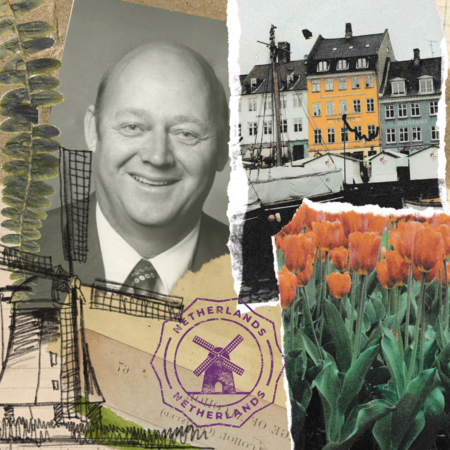1950s
Population of Pitt Meadows: 1600 people (1956)
Dutch Canadians were lucky. Pitt Meadows desperately needed people who knew how to make marshy, areas habitable, and people from the Netherlands had lots of experience in making that happen, so they were naturally suited to immigrate to the Pitt Polder area of Pitt Meadows.
How they would have gotten to Pitt Meadows during this time
It would have taken a ship between 7 to 10 days to arrive from the Netherlands to Canada. At this time, you could fly, but planes needed to be refuelled a lot more so the trip would take hours and hours and it was very expensive to fly at this time so only the super-rich could afford that luxury. To begin your journey, you would have had to go to a port city, this meant taking the train, car, or cycling to a port to catch your boat. You would then sail across the Atlantic towards Halifax, arriving in a place like Pier 21. Many young families were sponsored by farmers to work on their farms, which they would do for a year or two before buying their own farms. At Pier 21 they would have had to wait for proof of their sponsorship before they were allowed to depart to their destination. Once done, these immigrants would travel by train to the West Coast and then finally to Pitt Meadows where they would settle in the Pitt Polder Area.
Canada and the Netherlands have a close relationship. This relationship was cemented during the Second World War when the Canadian army liberated Dutch cities and we as a nation provided refuge to the Dutch Royal Family (every year the Dutch Royal Family and the People of the Netherlands send a gift of 10,000 tulips to Canada). Following the Second World War, many Dutch immigrants would find their way to Canada as their country had been devastated by the war and their economy was fragile. Around 2,000 Dutch war brides and their children also followed the soldiers home to Canada following the war.
History of Pitt Meadows during that time
The Dutch came into Pitt Meadows around 1950 when a man called Jan Blom decided he could take the area in North Pitt Meadows that always flooded and dike it to make it dry. This area was called Pitt Polder and he wanted to make it good farmland, and he did. Today people still farm there but there are also golf courses and other recreational activities in the area.
It is 1951, In Pitt Meadows the Lions Club forms and a steel bridge is constructed over the Alouette at Harris Road. March 1957 marks the opening of the first two-lane bridge over the Pitt, and the community has also gained a new church hall, a new volunteer fire department, a reactivated Pitt Meadows Day, a strong blueberry industry and Blueberry Co-Op, a new multi-room school (PM Elementary),and a growing population of Dutch citizens in the Pitt Polder area. Life is slower in Pitt Meadows as Edith McDermott retires as principal at Pitt Meadows Elementary, a new federal post office opens, and plans are being made for land acquisition for an airport.
What they would have brought with them
To immigrate at this time, the Dutch would have had to complete the necessary paperwork, pass medical testing, have the funds for transportation, and receive approval from the authorities. In 1946, Canadian residents could sponsor close relatives. The Immigration Act, of 1952 was also established without really changing much previous legislation from the previous Act of 1910, it largely codified existing practices and established a legislative framework that the government could enact additional orders and regulations.
At this time, after the Second World War, the Netherlands government wanted to limit money being taken out of the country, so they limited the amounts that immigrants could bring. They were however allowed to bring as many possessions with them as they liked, so lots of them would bring them in large wooden crates called “kists”. Families would load up their belongings and bring them with them to this new country.
*****
In the 1950s, there was a surge of Dutch immigrants moving into Pitt Polder. Sieb Swiestra arrived during this surge, and he created a lasting legacy in Pitt Meadows. His history follows.
Swierstra Family History
Sybren “Sieb” Swierstra was born in the Netherlands in 1931. He arrived in Canada in October of 1950 to work on a Dairy Farm. Following that he worked as a heavy-duty machine operator and later learned to become a skilled dragline operator. He formed his own company S.B. Excavating. In 1955, he officially became a Canadian Citizen! He was deeply passionate about the dyking system which is worked on in Pitt Polder. Sieb was very community-minded entering politics as a Director of the Dewdney Alouette Regional District. He served on the Pitt Meadows Council for several years.
One of the most important contributions Sieb made to Pitt Meadows was with Walter Laseur planning the cenotaph and helped organize the Remembrance Day ceremonies in the city (the first ceremony occurred on November 11th, 1990). He was a proud member of the Legion.
The Swierstra family has donated several items to the museum collection, Sieb helped the museum with explaining dyking and the Pitt Polder area and assisting with the Museum Discovery Box “Hailing from Holland”.
Sieb was part of a large group of immigrants who came to the Pitt Polder area following the reclamation efforts of Dr. Jan Blom. Some of the family names are Laseur, Menten, Vanbrunen, VanKamp, Greertsma, and Rannie.
*****
Without immigration, Canada would not be the country that it is today. This is a tale without an ending, as immigration continues as people keep looking for brighter horizons.

 604 465 4322
604 465 4322





